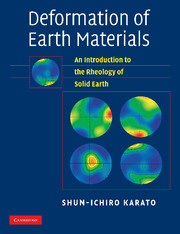Book contents
- Frontmatter
- Contents
- Preface
- Part I General background
- Part II Materials science of deformation
- 4 Elasticity
- 5 Crystalline defects
- 6 Experimental techniques for study of plastic deformation
- 7 Brittle deformation, brittle–plastic and brittle–ductile transition
- 8 Diffusion and diffusional creep
- 9 Dislocation creep
- 10 Effects of pressure and water
- 11 Physical mechanisms of seismic wave attenuation
- 12 Deformation of multi-phase materials
- 13 Grain size
- 14 Lattice-preferred orientation
- 15 Effects of phase transformations
- 16 Stability and localization of deformation
- Part III Geological and geophysical applications
- References
- Materials index
- Subject index
- Plate section
12 - Deformation of multi-phase materials
Published online by Cambridge University Press: 05 June 2012
- Frontmatter
- Contents
- Preface
- Part I General background
- Part II Materials science of deformation
- 4 Elasticity
- 5 Crystalline defects
- 6 Experimental techniques for study of plastic deformation
- 7 Brittle deformation, brittle–plastic and brittle–ductile transition
- 8 Diffusion and diffusional creep
- 9 Dislocation creep
- 10 Effects of pressure and water
- 11 Physical mechanisms of seismic wave attenuation
- 12 Deformation of multi-phase materials
- 13 Grain size
- 14 Lattice-preferred orientation
- 15 Effects of phase transformations
- 16 Stability and localization of deformation
- Part III Geological and geophysical applications
- References
- Materials index
- Subject index
- Plate section
Summary
Most parts of the Earth are made of multi-phase materials. The physical mechanisms of deformation of a multi-phase material differ from those of a homogeneous material in several ways. A key issue here is how the rate of deformation (or the strength of a polycrystalline material) is related to those of individual materials (or crystals) and their volume fraction, orientation and geometry. Experimental observations and theoretical models of the deformation of a multi-phase material are reviewed. It is shown that the plastic deformation of a multi-phase material is controlled not only by the rheological contrast (the contrast in effective viscosity) and the volume fraction of each phase but also by the stress–strain distribution that depends on the geometry of each phase. The case of partial melt deserves special attention. Mechanical contrast is large in this case and as a consequence the properties of a partial melt depend strongly on the fraction and geometry of the melt. Principles that determine the geometry of melt in a partially molten material are discussed.
Key words Reuss average (model), Voigt average (model), Hill average (model), Hoff's analogy, Taylor average (model), Sachs average (model), variational principle, self-consistent approach, percolation, partial melt, dihedral angle.
Introduction
So far, we have considered the deformation of single-phase, homogeneous materials. This is a natural starting point, but there are several fundamental differences in deformation and microstructural development between a single- and a multi-phase material.
- Type
- Chapter
- Information
- Deformation of Earth MaterialsAn Introduction to the Rheology of Solid Earth, pp. 214 - 231Publisher: Cambridge University PressPrint publication year: 2008



